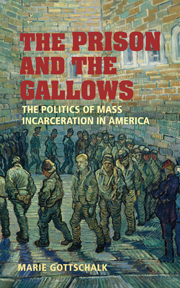Book contents
- Frontmatter
- Contents
- List of Figures and Table
- Preface and Acknowledgments
- 1 The Prison and the Gallows: The Construction of the Carceral State in America
- 2 Law, Order, and Alternative Explanations
- 3 Unlocking the Past: The Nationalization and Politicization of Law and Order
- 4 The Carceral State and the Welfare State: The Comparative Politics of Victims
- 5 Not the Usual Suspects: Feminists, Women's Groups, and the Anti-Rape Movement
- 6 The Battered-Women's Movement and the Development of Penal Policy
- 7 From Rights to Revolution: Prison Activism and the Carceral State
- 8 Capital Punishment, the Courts, and the Early Origins of the Carceral State, 1920s–1960s
- 9 The Power to Punish and Execute: The Political Development of Capital Punishment, 1972 to Today
- 10 Conclusion: Whither the Carceral State?
- Notes
- Select Bibliography
- Index
- Titles in the Series
2 - Law, Order, and Alternative Explanations
Published online by Cambridge University Press: 05 September 2012
- Frontmatter
- Contents
- List of Figures and Table
- Preface and Acknowledgments
- 1 The Prison and the Gallows: The Construction of the Carceral State in America
- 2 Law, Order, and Alternative Explanations
- 3 Unlocking the Past: The Nationalization and Politicization of Law and Order
- 4 The Carceral State and the Welfare State: The Comparative Politics of Victims
- 5 Not the Usual Suspects: Feminists, Women's Groups, and the Anti-Rape Movement
- 6 The Battered-Women's Movement and the Development of Penal Policy
- 7 From Rights to Revolution: Prison Activism and the Carceral State
- 8 Capital Punishment, the Courts, and the Early Origins of the Carceral State, 1920s–1960s
- 9 The Power to Punish and Execute: The Political Development of Capital Punishment, 1972 to Today
- 10 Conclusion: Whither the Carceral State?
- Notes
- Select Bibliography
- Index
- Titles in the Series
Summary
“Seek simplicity and distrust it.”
– Alfred North WhiteheadThe problem of the prison was central to major political theorists of the eighteenth and nineteenth centuries. The role that punishment and imprisonment served in maintaining social order, legitimizing the state, and reforming the soul were key concerns of thinkers like Mill, Bentham, Kant, Montesquieu, Tocqueville, and Francis Lieber, the first named professor of political science in the United States. Years ago prisons also transfixed the public. American penitentiaries were a prime sightseeing destination for foreign and domestic tourists. Prison officials charged entrance fees and put prisoners on view as if they were in a zoo, sometimes hosting thousands of tourists in a single day. Charles Dickens reportedly told the warden of Cherry Hill prison after a visit: “The Falls of Niagara and your Penitentiary are two objects I might almost say I most wish to see in America.” By contrast, the contemporary carceral state has been largely invisible. What caused the country's incarceration boom and the political, social, and economic consequences of this unprecedented experiment in public policy have not been a major focus of social science research or public concern.
This chapter critically analyzes half a dozen of the contending theories of the origins of the carceral state. It takes as its starting point that the penal system in any society cannot be understood as “an isolated phenomenon subject only to its own laws.” Rather, it is deeply embedded in a particular social, political, historical, and institutional context.
- Type
- Chapter
- Information
- The Prison and the GallowsThe Politics of Mass Incarceration in America, pp. 18 - 40Publisher: Cambridge University PressPrint publication year: 2006

